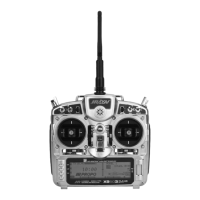G-26
3. Q:I’veheardthattheDSMsystemislesstolerantof
low voltage. Is that correct?
A:AllDSMreceivershaveanoperationalvoltagerange
of3.5to9volts.Withmostsystems,thisisnota
problem as most servos cease to operate at around
3.8volts.Whenusingmultiplehigh-currentdraw
servoswithasingleorinadequatebattery/power
source, heavy momentary loads can cause the
voltage to dip below this 3.5-volt threshold, causing
the entire system (servos and receiver) to brown
out.Whenthevoltagedropsbelowthelowvoltage
threshold (3.5 volts), the DSM receiver must reboot
(go through the start-up process of scanning the band
and finding the transmitter) and this can take several
seconds. Please read the receiver power requirement
on page G-24 as this explains how to test for and
prevent this occurrence.
4. Q:Sometimesmyreceiverlosesitsbindandwon’t
connect,requiringrebinding.Whathappensifthebind
is lost in flight?
A:Thereceiverwillneverloseitsbindunless
instructed to. It’s important to understand that during
the binding process the receiver not only learns the
GUID (code) of the transmitter but the transmitter
learns and stores the type of receiver it’s bound to. If
the bind button on the transmitter is pressed at any
time and the transmitter is turned on, the transmitter
looks for the binding protocol signal from a receiver.
If no signal is present, the transmitter no longer has
the correct information to connect to a specific receiver
and in essence the transmitter has been “unbound”
fromthereceiver.We’vehadseveralcustomersthat
use transmitter stands or trays that unknowingly
depress the bind button and the system is then turned
on, losing the necessary information to allow the
connectiontotakeplace.We’vealsohadcustomers
that didn’t fully understand the range test process
and pushed the bind button before turning on the
transmitter, also causing the system to “lose its bind.”
If, when turning on, the system fails to connect, one of
thefollowinghasoccurred:
•Thewrongmodelhasbeenselectedinthemodel
memory (ModelMatch).
•Thetransmitterisnearconductivematerial
(transmitter case, truck bed, etc.) and the reflected
2.4GHz energy is preventing the system from
connecting (see #2 above).
•Thebindbuttonwasunknowingly(orknowingly)
depressed and the transmitter was turned on
previously, causing the transmitter to no longer
recognize the receiver.
5. Q:CanIusea3-cellLi-Popackinmytransmitter?
A:No.AllcurrentJRandSpektrumtransmittersare
designedtooperateusinga9.6-volttransmitterpack.
Afullycharged3-cellLi-Popackputsout12.6volts.
Thishighervoltagecanoverloadthepower-regulating
transistor causing damage and or failure, possibly
in flight. Many of our customers have experienced
failuresusing3-cellLi-PopacksandtheiruseinJR
and Spektrum transmitters is highly advised against.
TheX95032.4systemwilloperateforover15hours
using a 2700mAh Ni-MH battery.
6. Q:HowimportantisitthatItestmysystemusinga
flight log?
A:Formostsportairplanesandhelicopters,theuse
of the flight log is unnecessary. For sophisticated
aircraft, especially those that have significant
conductive materials within the airframe (e.g. jets,
scaleairplanes,etc.),theFlightLogoffersanextra
measure of confidence that all radio components are
workingoptimally.TheFlightLogisanimportant
tool that confirms that the installation (position of the
internal and remote receivers relative to the conductive
materials in the aircraft) is optimized and that the
RF (radio) link is operating at the highest levels of
performance.
Tips on Using 2.4GHz Systems (continued)

